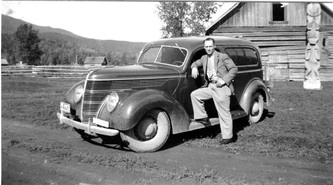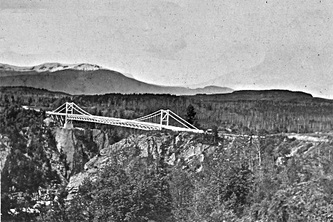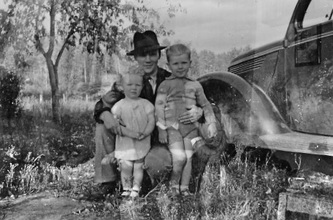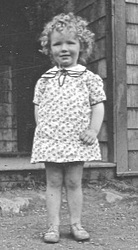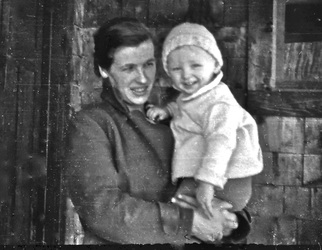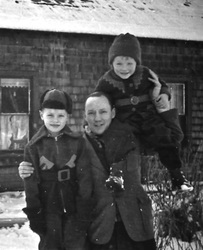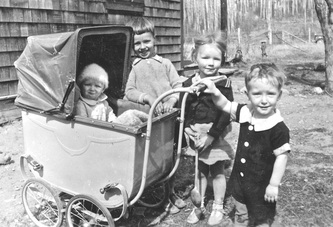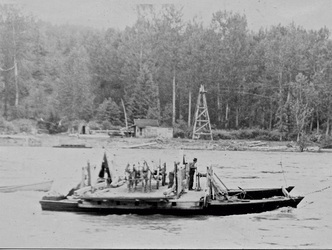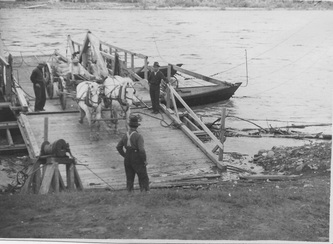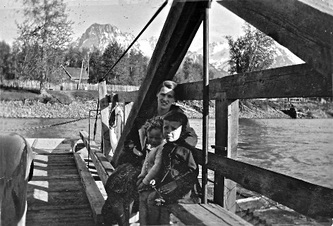The photo above: Mt Rocher de Boule taken at the junction of the Bulkley River which is flowing from the left, and the Skeena River, flowing from the right.
Seven - In Hazelton before the war
1938
In January of 1938 Charles applied and was accepted for enrolment in the correspondence course on Forest Management. He was sent the papers one at a time, and would receive each subsequent to completion of the preceding one.
At this time the Forest Service was still non-committal about employing Charles on any full-time basis, so on March 30th he again sat for and passed (for the second time) the Ranger’s Exam.
Once again he kept a record of the application form and his answers to the questions:
Education: Was in Form IV when he left Worksop College
Forest Service Experience: (As above) plus One year as Acting Ranger in charge of
Hazelton Ranger District, which included the handling of the “Kispiox” fire (98 men),
and the “Nash” fire (50 men).
Courses Taken: Have studied the Forest Branch Correspondence course on
the “Forest Act” & “Forest Management”.
Qualified at the Ranger’s Examination held at Burns Lake 21 April 1937.
Cruising Experience: As Acting Assistant & Acting Ranger have cruised a number of
areas in the region for timber sales covering cordwood, ties, saw-logs, cedar fence
posts, cedar poles, and piling.
Have also made numerous land examinations and pre-emption inspections.
Lumbering Experience:
Helped settlers take out saw-logs, building logs, and cord-wood.
Experience in scaling in connection with F.B. duties, but no scaler’s licence.
In April of 1938 he was notified by the District Forester of a complaint that had been made about something he had done – or not done. It seems that he had taken the Forestry car to be overhauled at the wrong garage – Benson’s. He hadn’t been aware that an informal agreement had been made by his predecessor to divide the Forestry automotive business between the two garages in town - obtain fuel at Benson’s Garage, but have repairs done at Martin’s Garage.
Apparently Martin had complained about the overhaul job. Charles’ reply was that he had been unaware of any understanding, but that he had felt justified in having the work done by Benson’s. He then did a little research. After going through the office car repair invoices in January 1939 he submitted a breakdown of the amounts spent in the period May to December 1938, by the Forest Service at each garage: Martin’s: $106.65; Benson’s: $65.10. Profits made were also calculated: Martin had netted $45.57; Benson’s net had been $26.48. He was also offended because Martin had complained that he was using the Forest Service vehicles for “joy-riding” – (using it for non-Forestry activities such as transporting his family.) He strongly denied this.
In May of 1938 they moved into a big house near the church owned by the Andersons – which, incidentally, was later occupied by the Reynolds family. In the summer that house came up for sale but at a price they couldn’t afford. So, when it sold in October of that year they were forced to move again.
In October Charles was able to rent a small house on the bank of the river just across the street from where they were, which belonged to Bill Sargent. Although he describes it as just a “shack” (later occupied by Eric Janze and family), because there was nothing else available they gladly took it. Unfortunately this uninsulated house was very uncomfortable during the very cold winter of 1938-39. In the effort to keep warm they went through many cords of wood that winter.
This very poor house was all they could find. Because the owner had plans to move the house and fix it up in the spring they were going to have to move again. At this time Charles initiated a request to the Forest Branch to build a Ranger’s residence in Hazelton as had been done in Burns Lake. The District Forester responded with a promise to make an effort on their behalf, but if there was nothing suitable in Old Hazelton, he, should search again, even in New or South Hazelton. This response was obviously due to the fact that in the depths of the Depression, government revenues were drastically reduced and all departments were being run with as small budgets as possible.
In April of 1939 Charles heard that Tom Marshall, partner in a local trucking company, had a small house at Two Mile for rent. This was located, as the name suggests, two miles out of Hazelton.
And, at the end of the summer he was accepted as Acting Ranger.
When they moved to Hazelton Charles had been informed by the locals of the presence of many grizzly bears in the nearby valleys and mountains. Hazelton was located at the confluence of two rivers I both of which there was an autumn salmon migration. As the salmon in the Skeena and Bulkley Rivers were was used by the bears to fatten up for the winter hibernation it was not uncommon to find them, where else? - along the rivers. His work often took him into the local forests and near the rivers, and as he knew how dangerous grizzly bears could be from his experiences in the wild areas of the Ootsa Lake region, he applied for official permission to buy a large caliber handgun to carry for self-protection. However, the police refused his request. It was obvious that they didn’t have to be out in the woods with him.
Finally, in July of 1937, he received permission to acquire and carry a .32 calibre Savage automatic, a small handgun, which, they pointed out, would have to be registered in his name. Fortunately he never ever had to use it, and those who know the size and power of a .32 calibre bullet, realize how totally inadequate a .32 calibre would be when facing a grizzly bear.
In those days of scarce employment, hardly anyone working for the government was able to take an annual holiday. Charles, who always had a number of irons in the fire, thought this to be rather unfair. After several memoranda, in which he was putting the case for an annual vacation with pay, A.E. Parlow, the District Forester advised him that he would be granted Holiday Leave with pay for one week, commencing November 1, providing that “you will have the work of the District in such shape that it can be left for a week, and it will not be necessary for us to have anyone there during that time.” As there had been some uncertainty whether the Civil Service Commissioner would grant full pay with the holiday, this must have been some relief.
1938
In January of 1938 Charles applied and was accepted for enrolment in the correspondence course on Forest Management. He was sent the papers one at a time, and would receive each subsequent to completion of the preceding one.
At this time the Forest Service was still non-committal about employing Charles on any full-time basis, so on March 30th he again sat for and passed (for the second time) the Ranger’s Exam.
Once again he kept a record of the application form and his answers to the questions:
Education: Was in Form IV when he left Worksop College
Forest Service Experience: (As above) plus One year as Acting Ranger in charge of
Hazelton Ranger District, which included the handling of the “Kispiox” fire (98 men),
and the “Nash” fire (50 men).
Courses Taken: Have studied the Forest Branch Correspondence course on
the “Forest Act” & “Forest Management”.
Qualified at the Ranger’s Examination held at Burns Lake 21 April 1937.
Cruising Experience: As Acting Assistant & Acting Ranger have cruised a number of
areas in the region for timber sales covering cordwood, ties, saw-logs, cedar fence
posts, cedar poles, and piling.
Have also made numerous land examinations and pre-emption inspections.
Lumbering Experience:
Helped settlers take out saw-logs, building logs, and cord-wood.
Experience in scaling in connection with F.B. duties, but no scaler’s licence.
In April of 1938 he was notified by the District Forester of a complaint that had been made about something he had done – or not done. It seems that he had taken the Forestry car to be overhauled at the wrong garage – Benson’s. He hadn’t been aware that an informal agreement had been made by his predecessor to divide the Forestry automotive business between the two garages in town - obtain fuel at Benson’s Garage, but have repairs done at Martin’s Garage.
Apparently Martin had complained about the overhaul job. Charles’ reply was that he had been unaware of any understanding, but that he had felt justified in having the work done by Benson’s. He then did a little research. After going through the office car repair invoices in January 1939 he submitted a breakdown of the amounts spent in the period May to December 1938, by the Forest Service at each garage: Martin’s: $106.65; Benson’s: $65.10. Profits made were also calculated: Martin had netted $45.57; Benson’s net had been $26.48. He was also offended because Martin had complained that he was using the Forest Service vehicles for “joy-riding” – (using it for non-Forestry activities such as transporting his family.) He strongly denied this.
In May of 1938 they moved into a big house near the church owned by the Andersons – which, incidentally, was later occupied by the Reynolds family. In the summer that house came up for sale but at a price they couldn’t afford. So, when it sold in October of that year they were forced to move again.
In October Charles was able to rent a small house on the bank of the river just across the street from where they were, which belonged to Bill Sargent. Although he describes it as just a “shack” (later occupied by Eric Janze and family), because there was nothing else available they gladly took it. Unfortunately this uninsulated house was very uncomfortable during the very cold winter of 1938-39. In the effort to keep warm they went through many cords of wood that winter.
This very poor house was all they could find. Because the owner had plans to move the house and fix it up in the spring they were going to have to move again. At this time Charles initiated a request to the Forest Branch to build a Ranger’s residence in Hazelton as had been done in Burns Lake. The District Forester responded with a promise to make an effort on their behalf, but if there was nothing suitable in Old Hazelton, he, should search again, even in New or South Hazelton. This response was obviously due to the fact that in the depths of the Depression, government revenues were drastically reduced and all departments were being run with as small budgets as possible.
In April of 1939 Charles heard that Tom Marshall, partner in a local trucking company, had a small house at Two Mile for rent. This was located, as the name suggests, two miles out of Hazelton.
And, at the end of the summer he was accepted as Acting Ranger.
When they moved to Hazelton Charles had been informed by the locals of the presence of many grizzly bears in the nearby valleys and mountains. Hazelton was located at the confluence of two rivers I both of which there was an autumn salmon migration. As the salmon in the Skeena and Bulkley Rivers were was used by the bears to fatten up for the winter hibernation it was not uncommon to find them, where else? - along the rivers. His work often took him into the local forests and near the rivers, and as he knew how dangerous grizzly bears could be from his experiences in the wild areas of the Ootsa Lake region, he applied for official permission to buy a large caliber handgun to carry for self-protection. However, the police refused his request. It was obvious that they didn’t have to be out in the woods with him.
Finally, in July of 1937, he received permission to acquire and carry a .32 calibre Savage automatic, a small handgun, which, they pointed out, would have to be registered in his name. Fortunately he never ever had to use it, and those who know the size and power of a .32 calibre bullet, realize how totally inadequate a .32 calibre would be when facing a grizzly bear.
In those days of scarce employment, hardly anyone working for the government was able to take an annual holiday. Charles, who always had a number of irons in the fire, thought this to be rather unfair. After several memoranda, in which he was putting the case for an annual vacation with pay, A.E. Parlow, the District Forester advised him that he would be granted Holiday Leave with pay for one week, commencing November 1, providing that “you will have the work of the District in such shape that it can be left for a week, and it will not be necessary for us to have anyone there during that time.” As there had been some uncertainty whether the Civil Service Commissioner would grant full pay with the holiday, this must have been some relief.
1939
On 1 June 1939 Charles was was notified by R.C. (Bob) St. Clair, the new District Forester, that his appointment as Ranger in the Hazelton district. had become permanent.
On 18 July he was he was notified by J.E. Mathieson, the Fire Inspector, that he was appointed as Special Constable under the Forest Act.
For 1939 Charles worked as the Ranger at Hazelton. While they were at Two-Mile, he had fixed the house up by moving the staircase to a more convenient location, putting a pump (a hand pump) in the kitchen, and making other improvements.
In 1939 he heard of an opening for a Ranger in Dawson Creek, where the F.B. had had a house built for the Ranger, and expressed an interest in being transferred to that point. Housing in Hazelton was still hard to find, and he had concerns about the education of his children when they reached school age.
It was at Two Mile that he had a terrible accident and nearly severed his thumb with his axe while cutting kindling for starting fires. He then drove himself the mile to the hospital where the doctor did remarkable job in facilitating the healing of the injury.
But in September an event long talked about and even expected, happened - the Germans invaded Poland. Almost immediately Canada declared war on Germany so for Canadians World War II had started..
On 1 June 1939 Charles was was notified by R.C. (Bob) St. Clair, the new District Forester, that his appointment as Ranger in the Hazelton district. had become permanent.
On 18 July he was he was notified by J.E. Mathieson, the Fire Inspector, that he was appointed as Special Constable under the Forest Act.
For 1939 Charles worked as the Ranger at Hazelton. While they were at Two-Mile, he had fixed the house up by moving the staircase to a more convenient location, putting a pump (a hand pump) in the kitchen, and making other improvements.
In 1939 he heard of an opening for a Ranger in Dawson Creek, where the F.B. had had a house built for the Ranger, and expressed an interest in being transferred to that point. Housing in Hazelton was still hard to find, and he had concerns about the education of his children when they reached school age.
It was at Two Mile that he had a terrible accident and nearly severed his thumb with his axe while cutting kindling for starting fires. He then drove himself the mile to the hospital where the doctor did remarkable job in facilitating the healing of the injury.
But in September an event long talked about and even expected, happened - the Germans invaded Poland. Almost immediately Canada declared war on Germany so for Canadians World War II had started..
1940
1940 arrived and Charles was still working as the Ranger in Hazelton.
They were living at Two Mile when on 1st October, 1940, their third child, James Lucas, was born.
The house at Two Mile was situated in a 10 or 15 acre field, next door to a similar sized field which was part of a local dairy farm owned by Jacob Senden and his family. Marion normally purchased her milk from them, so one day, expectantly large with Jim, when she discovered she was out of milk she determined to walk the short distance to Senden’s to buy some more milk. For a short cut she cut through their field on her way next door to purchase another quart or two. Slipping over the fence she proceeded along the edge of the road. It wasn’t until she was half-way to Senden’s that she realized that their bull was loose outside their fence. As this bull was quite frisky and had been involved in several escapades with unwary pedestrians in past months, this gave her a start, and she felt she had to run the rest of the way.
When Mrs. Senden, the farmer’s wife, realized what had happened, she gave her husband a very good scolding for his carelessness in allowing the bull to be loose. Senden then went out and collected his bull.
On October 1, 1940 when Marion went into labour, Charles rushed her to the hospital. By the time her labours were done she had delivered a beautiful baby boy. The next day the family visited her in the hospital where they also saw the baby. It was a few days before he was given a name which turned out to be James Lucas. The family was now complete!
At the house in Two Mile, because Charles was two miles removed from a telephone, the use of which was necessary for receiving forest fires reports and for other emergencies, he made a plea to the District Forester to have one installed. St. Clair conferred with Victoria, who didn’t want to set a precedent by installing a phone in his home, but if he was to have one installed he could submit the cost and it would be borne separately from any expense account he submitted.
Charles always enjoyed social events, such as having friends over, and having an evening of conversation. Wherever he lived he became active with other young folk in some of the activities of the community. At this time in Hazelton, there was a Little Theatre group whose activities included presenting plays in the local community hall. Charles had been involved at school with the presentation of some of Shakespeare’s plays which had inculcated in him a love of thespian activities. This led him to be involved in the theatre activities in Hazelton.
Peter remembers when he was four, being brought out of bed one summer evening to be taken off to the local community hall where his group was putting on a play. This play had a certain amount of dialogue in which the characters were loudly arguing with each other, one of whom was Charles. In fact Peter seems to remember someone taking a punch at his dad. Seeing this made him very upset, so that he can remember the incident to this day. Despite the reassurances of his mother, he felt very anxious for his dad’s safety, which, of course, disappeared when he saw him after the play.
1940 arrived and Charles was still working as the Ranger in Hazelton.
They were living at Two Mile when on 1st October, 1940, their third child, James Lucas, was born.
The house at Two Mile was situated in a 10 or 15 acre field, next door to a similar sized field which was part of a local dairy farm owned by Jacob Senden and his family. Marion normally purchased her milk from them, so one day, expectantly large with Jim, when she discovered she was out of milk she determined to walk the short distance to Senden’s to buy some more milk. For a short cut she cut through their field on her way next door to purchase another quart or two. Slipping over the fence she proceeded along the edge of the road. It wasn’t until she was half-way to Senden’s that she realized that their bull was loose outside their fence. As this bull was quite frisky and had been involved in several escapades with unwary pedestrians in past months, this gave her a start, and she felt she had to run the rest of the way.
When Mrs. Senden, the farmer’s wife, realized what had happened, she gave her husband a very good scolding for his carelessness in allowing the bull to be loose. Senden then went out and collected his bull.
On October 1, 1940 when Marion went into labour, Charles rushed her to the hospital. By the time her labours were done she had delivered a beautiful baby boy. The next day the family visited her in the hospital where they also saw the baby. It was a few days before he was given a name which turned out to be James Lucas. The family was now complete!
At the house in Two Mile, because Charles was two miles removed from a telephone, the use of which was necessary for receiving forest fires reports and for other emergencies, he made a plea to the District Forester to have one installed. St. Clair conferred with Victoria, who didn’t want to set a precedent by installing a phone in his home, but if he was to have one installed he could submit the cost and it would be borne separately from any expense account he submitted.
Charles always enjoyed social events, such as having friends over, and having an evening of conversation. Wherever he lived he became active with other young folk in some of the activities of the community. At this time in Hazelton, there was a Little Theatre group whose activities included presenting plays in the local community hall. Charles had been involved at school with the presentation of some of Shakespeare’s plays which had inculcated in him a love of thespian activities. This led him to be involved in the theatre activities in Hazelton.
Peter remembers when he was four, being brought out of bed one summer evening to be taken off to the local community hall where his group was putting on a play. This play had a certain amount of dialogue in which the characters were loudly arguing with each other, one of whom was Charles. In fact Peter seems to remember someone taking a punch at his dad. Seeing this made him very upset, so that he can remember the incident to this day. Despite the reassurances of his mother, he felt very anxious for his dad’s safety, which, of course, disappeared when he saw him after the play.
1940 (continued)
Wherever he was needed Charles willingly served as an unpaid church organist. In Hazelton at first he was organist in the Anglican Church. After a period with them he moved over to the local United Church.
This moving between the churches wasn’t as strange as it sounds. In England he had had a background in both churches. His father came from a strong Wesleyan Methodist tradition – one of the United Church’s roots in Canada being the Methodist church – and both his mother and his school had been Church of England, also known as the Anglican Church, as the source of their faith. Through them he had also attended, and become familiar with, the Anglican Church in England.
Another type of situation in which Peter remembers feeling quite anxious occurred whenever, which only happened on two or three occasions, that Charles had to talk to the local BC Police constable in connection with some of his dealings with the individuals in the public. Of course we were quite versed in the job of the policeman – we knew that policemen “took people off to jail!” In those days, stories of the German Gestapo unexpectedly showing up at people’s homes in the middle of the night were also being told. In fact, their mother used to take them to movies that showed spies and police in very dark scenes. So, occasionally when the policeman arrived in their yard to see Charles, and he would go out to talk with him Peter would get visions of jail cells and of his father mysteriously being taken away. He remembers he always felt better when Charles came back into the house and reassured them that it was only Forestry business that he had had with the Constable.
Charles always drove one of the Forestry Fords – usually a panel van. It was usually a fairly recent model, which in those days had a pointed hood and grill, like the underside of a boat, and contrasted with the more common 1920s styles of cars. Most people still drove cars with a vertical radiator, vertical sides, vertical windshield, spoke wheels, and usually painted black or some other dark shade.
In the winter his tires were called “knobbies as they had rubber nobs molded on the tread for better grip in the snowy conditions. No-one had produced the type of carefully engineered snow tire such as we are informed about today in the advertisements. The roads would often be glare ice with no sand was laid down to improve the traction. He said that he was once driving on glare ice and he had had to sneeze. Of course when you sneeze you close your eyes for a moment. The result was that he lost control and ended up in the ditch. After that he was always afraid to sneeze on a winter road!
Charles’ work-day included a lot of the same tasks that he had done out of the Smithers office. His territory stretched west to Kitwanga, north past Kispiox, and east to Moricetown. The roads, being gravel were subject to “washboarding” (the development of series of evenly spaced bumps, especially on hills). His daily distances were often long and rough. He dealt with big companies such as Olaf Hanson’s Pole and Tie company, and with many smaller lumber operations.
Actually, in those days we heard of many people going into the ditch in the winter. The roads would become glare ice, and with the crown in the centre of the gravel road, it was often difficult to even stand up, let alone walk or drive. So everyone carried a heavy rope or cable, which would be used to pull either themselves or their neighbour out of the ditches that were an inevitable part of driving.
And you never passed anyone stopped on the side of the road. If you ever saw someone stopped it was always, “Is everything okay?” Of course, if it wasn’t okay it was your neighbourly duty to render whatever assistance you could.
In those days you could cross the Bulkley River on a bridge to the south of Old Hazelton, and heading across a big field, climb up the hill on the other side and travel to South Hazelton perched on the ridge where it was visible from the old town, and where the CNR ran. When we went back after the war, that route to “South-town” was no longer available. The bridge had been washed out by ice during a spring breakup when we were away during the war, and was never replaced.
Occasionally an aircraft would land on that big field across the river. One time when Peter was about four, for some reason, which he never did understand, Charles met the pilot of a biplane that had landed on the field. He wanted a picture of the plane, so he took a photo with Peter perched on the wheel of the aircraft, and the pilot standing nearby. Peter still remembers that experience and has the photo to prove it!
For Charles and Marion, their holiday for October 1941 was to visit Gladstone and Dorothy Fiddes in Fort Simpson, just north of Prince Rupert, where he was the resident physician for the Department of Indian Affairs.
In September 1939 during the time Charles was employed as the Forest Ranger at Hazelton, some R.C.A.F. Recruiting Officers visited Hazelton. Charles, who was still a loyal (and at times fervent) British subject, and who had always been attracted by new experiences, went and talked to them. Of course, along with the rest of the citizens of the Commonwealth, he was irate at the actions of the Germans in Poland and the rest of Europe, so was curious enough to go for an interview. By the end of the evening he had signed up for service with the Air Force. And, based upon his experience and training in the OTC – the Officer Training Corps, at his school, and subject to further approval, he was assured of a commission. The Forest Service had already issued a page of regulations in 1939, which assured their employees who wanted to join the National Effort, of the conditions of their reinstatement.
Wherever he was needed Charles willingly served as an unpaid church organist. In Hazelton at first he was organist in the Anglican Church. After a period with them he moved over to the local United Church.
This moving between the churches wasn’t as strange as it sounds. In England he had had a background in both churches. His father came from a strong Wesleyan Methodist tradition – one of the United Church’s roots in Canada being the Methodist church – and both his mother and his school had been Church of England, also known as the Anglican Church, as the source of their faith. Through them he had also attended, and become familiar with, the Anglican Church in England.
Another type of situation in which Peter remembers feeling quite anxious occurred whenever, which only happened on two or three occasions, that Charles had to talk to the local BC Police constable in connection with some of his dealings with the individuals in the public. Of course we were quite versed in the job of the policeman – we knew that policemen “took people off to jail!” In those days, stories of the German Gestapo unexpectedly showing up at people’s homes in the middle of the night were also being told. In fact, their mother used to take them to movies that showed spies and police in very dark scenes. So, occasionally when the policeman arrived in their yard to see Charles, and he would go out to talk with him Peter would get visions of jail cells and of his father mysteriously being taken away. He remembers he always felt better when Charles came back into the house and reassured them that it was only Forestry business that he had had with the Constable.
Charles always drove one of the Forestry Fords – usually a panel van. It was usually a fairly recent model, which in those days had a pointed hood and grill, like the underside of a boat, and contrasted with the more common 1920s styles of cars. Most people still drove cars with a vertical radiator, vertical sides, vertical windshield, spoke wheels, and usually painted black or some other dark shade.
In the winter his tires were called “knobbies as they had rubber nobs molded on the tread for better grip in the snowy conditions. No-one had produced the type of carefully engineered snow tire such as we are informed about today in the advertisements. The roads would often be glare ice with no sand was laid down to improve the traction. He said that he was once driving on glare ice and he had had to sneeze. Of course when you sneeze you close your eyes for a moment. The result was that he lost control and ended up in the ditch. After that he was always afraid to sneeze on a winter road!
Charles’ work-day included a lot of the same tasks that he had done out of the Smithers office. His territory stretched west to Kitwanga, north past Kispiox, and east to Moricetown. The roads, being gravel were subject to “washboarding” (the development of series of evenly spaced bumps, especially on hills). His daily distances were often long and rough. He dealt with big companies such as Olaf Hanson’s Pole and Tie company, and with many smaller lumber operations.
Actually, in those days we heard of many people going into the ditch in the winter. The roads would become glare ice, and with the crown in the centre of the gravel road, it was often difficult to even stand up, let alone walk or drive. So everyone carried a heavy rope or cable, which would be used to pull either themselves or their neighbour out of the ditches that were an inevitable part of driving.
And you never passed anyone stopped on the side of the road. If you ever saw someone stopped it was always, “Is everything okay?” Of course, if it wasn’t okay it was your neighbourly duty to render whatever assistance you could.
In those days you could cross the Bulkley River on a bridge to the south of Old Hazelton, and heading across a big field, climb up the hill on the other side and travel to South Hazelton perched on the ridge where it was visible from the old town, and where the CNR ran. When we went back after the war, that route to “South-town” was no longer available. The bridge had been washed out by ice during a spring breakup when we were away during the war, and was never replaced.
Occasionally an aircraft would land on that big field across the river. One time when Peter was about four, for some reason, which he never did understand, Charles met the pilot of a biplane that had landed on the field. He wanted a picture of the plane, so he took a photo with Peter perched on the wheel of the aircraft, and the pilot standing nearby. Peter still remembers that experience and has the photo to prove it!
For Charles and Marion, their holiday for October 1941 was to visit Gladstone and Dorothy Fiddes in Fort Simpson, just north of Prince Rupert, where he was the resident physician for the Department of Indian Affairs.
In September 1939 during the time Charles was employed as the Forest Ranger at Hazelton, some R.C.A.F. Recruiting Officers visited Hazelton. Charles, who was still a loyal (and at times fervent) British subject, and who had always been attracted by new experiences, went and talked to them. Of course, along with the rest of the citizens of the Commonwealth, he was irate at the actions of the Germans in Poland and the rest of Europe, so was curious enough to go for an interview. By the end of the evening he had signed up for service with the Air Force. And, based upon his experience and training in the OTC – the Officer Training Corps, at his school, and subject to further approval, he was assured of a commission. The Forest Service had already issued a page of regulations in 1939, which assured their employees who wanted to join the National Effort, of the conditions of their reinstatement.
1941
Finally, in the fall of 1941, two years after talking to the RCAF recruiters, Charles finally heard from the Recruiting Centre asking for proof of his education and his former service. He replied with the last school reports in his possession and his O.T.C. reports.
Then, he received a letter dated December 4th 1941, advising him that subject to a satisfactory chest x-ray he had been selected for a commission in the Special Reserve, RCAF, Non-Flying List, Aerodrome Control Branch, with the rank of Pilot Officer. He was to present himself for X-ray examination at the RCAF Recruiting Centre, Provincial Building, Edmonton, Alberta.
Once the X-ray was approved, he was to report to #3 Manning Depot in Edmonton on January 9th 1942.
Because of the difficulty of reporting to Edmonton for the X-ray, he was advised to have an X-ray taken in Hazelton and to report to the RCAF on January 8th to have an official X-ray taken, before his training was to start on January 9th.
Charles left for Edmonton on January 2nd 1942, getting up at 2 A.M. when it was -40 degrees Fahrenheit, and drove to the train, where he left the car to be picked up by his assistant, Henry Willan.
Finally, in the fall of 1941, two years after talking to the RCAF recruiters, Charles finally heard from the Recruiting Centre asking for proof of his education and his former service. He replied with the last school reports in his possession and his O.T.C. reports.
Then, he received a letter dated December 4th 1941, advising him that subject to a satisfactory chest x-ray he had been selected for a commission in the Special Reserve, RCAF, Non-Flying List, Aerodrome Control Branch, with the rank of Pilot Officer. He was to present himself for X-ray examination at the RCAF Recruiting Centre, Provincial Building, Edmonton, Alberta.
Once the X-ray was approved, he was to report to #3 Manning Depot in Edmonton on January 9th 1942.
Because of the difficulty of reporting to Edmonton for the X-ray, he was advised to have an X-ray taken in Hazelton and to report to the RCAF on January 8th to have an official X-ray taken, before his training was to start on January 9th.
Charles left for Edmonton on January 2nd 1942, getting up at 2 A.M. when it was -40 degrees Fahrenheit, and drove to the train, where he left the car to be picked up by his assistant, Henry Willan.





